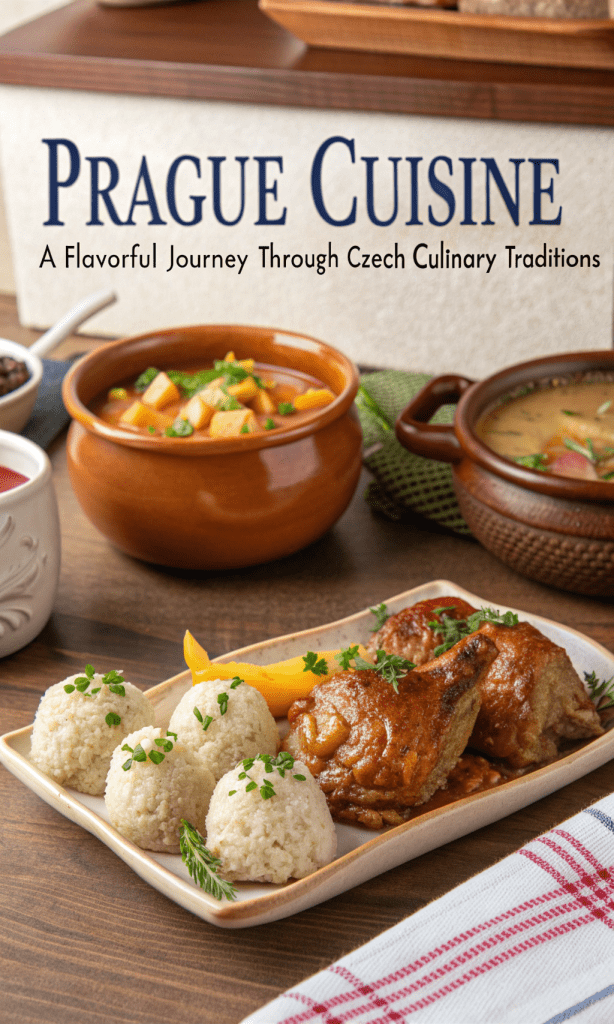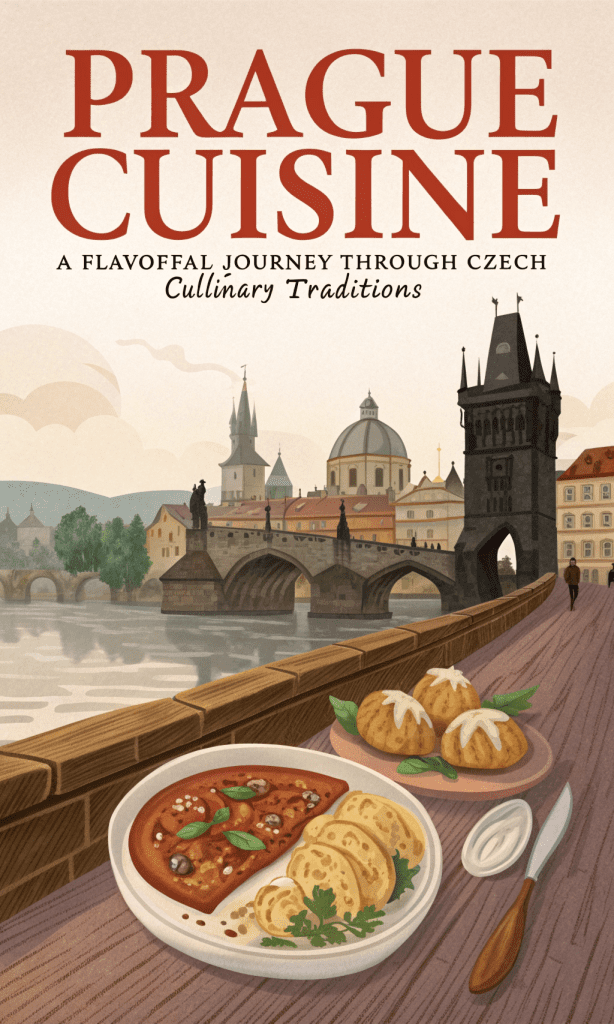
Prague cuisine captures the heart of Czech culture with its hearty, flavorful dishes that reflect centuries of history, regional influences, and a deep love for comforting, home-cooked meals. This vibrant culinary tradition, rooted in Central Europe, blends rustic ingredients with time-honored techniques to create meals that warm the soul. From savory dumplings to rich stews, Prague’s food scene offers a delightful mix of flavors that draw both locals and tourists. In this article, we explore the origins of Prague cuisine, how to prepare its iconic dishes, their nutritional value, and why this cuisine remains a cornerstone of Czech identity.
The Origins of Prague Cuisine
Prague cuisine traces its roots to the heart of the Czech Republic, where the city of Prague has long served as a cultural and culinary hub. Influenced by neighboring countries like Germany, Austria, and Hungary, Czech food reflects a blend of Central European traditions. Historically, Prague’s cuisine developed from the need to create filling, affordable meals using locally available ingredients like pork, potatoes, cabbage, and root vegetables. The Bohemian region, where Prague sits, embraced hearty dishes to sustain farmers and workers through cold winters.
Medieval feasts in Prague’s castles featured roasted meats and freshly baked bread, while peasant kitchens relied on stews and dumplings to stretch ingredients. Over time, dishes like goulash and svíčková (marinated beef with cream sauce) became staples, reflecting the city’s knack for transforming simple ingredients into flavorful masterpieces. Today, Prague’s cuisine retains its rustic charm while incorporating modern twists in the city’s vibrant restaurant scene.
Iconic Dishes of Prague Cuisine
Prague cuisine shines through its signature dishes, each telling a story of tradition and flavor. Below, we dive into some of the most beloved dishes, their preparation methods, and what makes them unique.
1. Svíčková na Smetaně (Marinated Beef with Cream Sauce)
Svíčková stands as one of Prague’s most iconic dishes, featuring tender beef sirloin marinated in a rich, creamy sauce. This dish, often served at family gatherings and celebrations, pairs beautifully with knedlíky (Czech dumplings) and a dollop of cranberry sauce.
How to Make Svíčková
Ingredients (Serves 4):
- 1.5 lbs beef sirloin
- 2 cups beef broth
- 1 cup heavy cream
- 2 carrots, diced
- 1 parsnip, diced
- 1 celery root, diced
- 1 onion, chopped
- 2 bay leaves
- 5 peppercorns
- 2 tbsp vinegar
- 2 tbsp flour
- 2 tbsp butter
- Salt and pepper to taste
- Cranberry sauce for serving
- 8 slices of knedlíky (recipe below)
Instructions:
- Marinate the beef sirloin with vinegar, bay leaves, peppercorns, and a pinch of salt for at least 24 hours in the refrigerator.
- Remove the beef from the marinade, pat dry, and sear in a hot pan with butter until browned on all sides.
- In a large pot, sauté carrots, parsnip, celery root, and onion until softened.
- Add the seared beef, beef broth, and marinade spices to the pot. Simmer for 2 hours until the beef is tender.
- Remove the beef and blend the vegetables with the broth to create a smooth sauce. Stir in cream and flour to thicken.
- Slice the beef thinly, pour the sauce over it, and serve with knedlíky and cranberry sauce.
Nutritional Value (per serving):
- Calories: ~600 kcal
- Protein: 45g
- Fat: 35g
- Carbohydrates: 20g
- Key Nutrients: High in protein, vitamin A (from carrots), and iron.
2. Knedlíky (Czech Dumplings)
Knedlíky, or Czech dumplings, form the backbone of Prague cuisine. These soft, steamed bread dumplings soak up sauces and complement dishes like svíčková and goulash.
How to Make Knedlíky
Ingredients (Makes 8 slices):
- 2 cups all-purpose flour
- 1 cup milk, lukewarm
- 1 egg
- 1 tsp active dry yeast
- 1 tsp sugar
- 1 tsp salt
- 1 slice of white bread, cubed
Instructions:
- Dissolve yeast and sugar in lukewarm milk. Let it sit for 10 minutes until frothy.
- In a large bowl, mix flour, salt, egg, and the yeast mixture. Knead until a soft dough forms.
- Add bread cubes to the dough and knead lightly to incorporate.
- Cover and let the dough rise for 1 hour until doubled in size.
- Divide the dough into two portions, shape into logs, and steam for 20 minutes in a steamer.
- Slice the dumplings into rounds and serve warm with sauces or stews.
Nutritional Value (per slice):
- Calories: ~150 kcal
- Protein: 5g
- Fat: 2g
- Carbohydrates: 28g
- Key Nutrients: Provides carbohydrates for energy and small amounts of calcium from milk.
3. Vepřo Knedlo Zelo (Pork, Dumplings, and Sauerkraut)
This classic dish combines roasted pork, knedlíky, and tangy sauerkraut for a quintessential Prague meal. It’s a favorite in local pubs and homes alike.
How to Make Vepřo Knedlo Zelo
Ingredients (Serves 4):
- 1.5 lbs pork shoulder
- 1 onion, chopped
- 2 cloves garlic, minced
- 1 tsp caraway seeds
- 2 cups sauerkraut, drained
- 1 cup beer (preferably Czech, like Pilsner Urquell)
- 2 tbsp vegetable oil
- Salt and pepper to taste
- 8 slices of knedlíky
Instructions:
- Preheat the oven to 350°F (175°C). Rub the pork shoulder with salt, pepper, and caraway seeds.
- Heat oil in a roasting pan and sear the pork on all sides.
- Add onion, garlic, and beer to the pan. Roast for 1.5–2 hours until the pork is tender.
- Heat sauerkraut in a saucepan with a splash of water until warmed through.
- Slice the pork, serve with knedlíky, and top with sauerkraut.
Nutritional Value (per serving):
- Calories: ~700 kcal
- Protein: 50g
- Fat: 40g
- Carbohydrates: 25g
- Key Nutrients: Rich in protein, vitamin C (from sauerkraut), and B vitamins.

4. Guláš (Czech Goulash)
Czech goulash, a hearty beef stew with paprika and onions, warms the soul on chilly Prague evenings. It’s often served with knedlíky or bread to soak up the flavorful sauce.
How to Make Czech Goulash
Ingredients (Serves 4):
- 1.5 lbs beef chuck, cubed
- 2 onions, chopped
- 2 tbsp paprika
- 1 tsp caraway seeds
- 2 cloves garlic, minced
- 2 tbsp tomato paste
- 2 cups beef broth
- 2 tbsp vegetable oil
- Salt and pepper to taste
- 8 slices of knedlíky or crusty bread
Instructions:
- Heat oil in a large pot and sauté onions until golden.
- Add beef cubes and brown on all sides.
- Stir in paprika, caraway seeds, garlic, and tomato paste. Cook for 2 minutes.
- Pour in beef broth, season with salt and pepper, and simmer for 1.5 hours until the beef is tender.
- Serve hot with knedlíky or bread.
Nutritional Value (per serving):
- Calories: ~550 kcal
- Protein: 40g
- Fat: 30g
- Carbohydrates: 15g
- Key Nutrients: High in protein, iron, and vitamin B12.
Nutritional Benefits of Prague Cuisine
Prague cuisine, while hearty and indulgent, offers a range of nutritional benefits when enjoyed in moderation. The cuisine relies heavily on protein-rich meats like pork and beef, which provide essential amino acids and iron for muscle health and energy. Vegetables like cabbage, carrots, and celery root add fiber, vitamins A and C, and antioxidants. Sauerkraut, a fermented food, supports gut health with probiotics. However, dishes like svíčková and vepřo knedlo zelo can be high in fat and calories due to cream sauces and pork, so portion control is key for a balanced diet.
Knedlíky, while carb-heavy, provide a steady source of energy, making them ideal for active lifestyles. Pairing these dishes with lighter sides, like fresh salads or pickled vegetables, balances the meal’s richness. Prague’s cuisine also incorporates herbs and spices like caraway and paprika, which add flavor without extra calories and offer anti-inflammatory properties.
Where to Experience Prague Cuisine
Prague’s food scene thrives in its cozy pubs, modern restaurants, and bustling markets. For an authentic experience, visit traditional establishments like U Fleků, one of Prague’s oldest beer halls, where you can savor goulash and knedlíky alongside a pint of Czech beer. Lokál Dlouhá offers classic dishes like svíčková in a lively atmosphere, while Café Savoy elevates Prague cuisine with refined presentations. For a taste of street food, head to the Havelská Market, where vendors serve warm, freshly made knedlíky and sausages.
If you’re visiting Prague, explore the city’s Christmas markets in winter for seasonal treats like trdelník (a sweet, chimney-shaped pastry) and mulled wine, which complement the hearty dishes of Prague cuisine. Many restaurants also offer vegetarian versions of classics, such as mushroom goulash or vegetable-stuffed knedlíky, catering to diverse diets.
Tips for Cooking Prague Cuisine at Home
Recreating Prague cuisine at home brings the flavors of the Czech Republic to your kitchen. Here are some tips to ensure success:
- Use Fresh Ingredients: Opt for high-quality meats and fresh vegetables to capture authentic flavors.
- Master Knedlíky: Practice steaming dumplings to achieve the perfect soft, fluffy texture.
- Balance Flavors: Pair rich dishes with tangy sides like sauerkraut or cranberry sauce to cut through the heaviness.
- Experiment with Beer: Incorporate Czech beers like Pilsner Urquell into stews for added depth.
- Keep It Simple: Prague cuisine thrives on straightforward techniques, so focus on bold flavors rather than complex methods.
The Cultural Significance of Prague Cuisine
Prague cuisine reflects the Czech Republic’s history of resilience and community. Dishes like vepřo knedlo zelo and svíčková bring families together, often served during holidays or Sunday lunches. The act of sharing a steaming plate of goulash or slicing knedlíky at the table fosters connection, making food a central part of Czech culture. In Prague, meals are more than sustenance—they’re a celebration of heritage, passed down through generations.
The cuisine also showcases the Czech love for beer, with many dishes incorporating it as an ingredient or pairing. Prague’s beer culture, rooted in centuries-old breweries, complements the hearty, savory flavors of its food, creating a perfect harmony that defines the dining experience.
Modern Twists on Prague Cuisine
While Prague cuisine remains rooted in tradition, modern chefs in the city push boundaries by adding contemporary flair. Restaurants like Field and La Degustation Bohême Bourgeoise offer elevated takes on classics, using local ingredients in innovative ways. For example, svíčková might feature sous-vide beef or a lighter sauce, while knedlíky could incorporate herbs or whole grains for a healthier twist.
Vegetarian and vegan options also gain traction in Prague, with dishes like lentil goulash or roasted vegetable knedlíky appearing on menus. These adaptations ensure Prague cuisine evolves while honoring its roots, making it accessible to a global audience.
Why Prague Cuisine Stands Out
Prague cuisine stands out for its ability to balance simplicity with bold, comforting flavors. The use of affordable ingredients like pork, potatoes, and cabbage makes it approachable, while the depth of flavor from slow cooking and thoughtful seasoning elevates it to something special. Whether you’re dining in a historic Prague pub or cooking svíčková at home, the cuisine offers a taste of Czech warmth and hospitality.
Its versatility also shines through. From cozy family dinners to festive holiday feasts, Prague cuisine adapts to any occasion. The cuisine’s reliance on local, seasonal ingredients aligns with modern sustainability trends, making it both timeless and relevant.
Prague cuisine invites you to savor the rich, hearty flavors of the Czech Republic, where every dish tells a story of tradition, community, and creativity. From the tender beef of svíčková to the fluffy knedlíky soaking up savory sauces, these dishes capture the essence of Prague’s culinary heritage. By exploring their origins, learning to cook them, and understanding their nutritional value, you can bring a piece of Prague to your table. Whether you’re a food enthusiast or a curious traveler, Prague cuisine offers a delicious journey worth taking.

